Haglund’s deformity
Let me try to demystify one type of heel pain known simply as the pump bump. Patients often ask how a heel bump arises and what we can do about my heel bump. Vaishya (2016) calls it a ‘common but mysterious condition’ in his paper. The reader needs to be aware that heel bump is a simplification and has some complex names. There are plenty of reasons for heel pain, and this is one. The retro calcaneal exostosis or Haglund’s deformity sound mysterious. Haglund, as a name for a heel condition, was so called after the man who described the problem in 1927.
I have this heel condition myself. My problem has been with me for thirty years. It was not until I was in my late forties that I experienced issues. My main concern was whilst driving, then latterly when wearing some designs of shoes. This has made me more aware of the design of my shoes. Pressure from the floor of the car stung my foot like crazy because my heel rubbed the skin while the foot was against the floor of the vehicle. There were times when some shoes could rub the skin, forming a blister.
What is it?
The condition is not a disease but a deformity of the back of the heel bone (calcaneus). The term syndrome suggests that there is more than one condition. Those who read my articles regularly know I try to keep descriptions as simple as possible. Here is Vaishya’s complicated reasoning about the condition, but I will explain all the jargon after his paragraph.
Haglund’s deformity is an abnormality of the posterosuperior part of the calcaneus, where there is a bony enlargement at the attachment of the Achilles tendon. The adjoining soft tissues can irritate when this bony lump rubs against rigid shoes. It often leads to retrocalcaneal bursitis, calcaneal tendon bursitis, and thickening and inflammation of the calcaneal tendon. This combination of pathology is known as Haglund’s syndrome. Inflammation of the different parts of soft tissue in the area can lead to an isolated condition; however, the treatment options are different in these conditions, so they should be differentiated.
We now know the heel has a protrusion, but let’s keep it simple. ‘Posterosuperior‘ is an anatomical position. The back of the heel! What about the tendon? Most people only have a minor form of the bump. However, in a few people, the bump becomes larger. If the extent of the bone extends across the heel, where the big tendon of the calf is anchored, then part of the tendon can also be involved. The tendon can be damaged, or the skin can form a spongy fluid-filled sac called a bursa. Where the deep tendon sac becomes inflamed, the condition can deteriorate. The skin surface can form a blister.
How is it caused?
Altered Biomechanics
The skin rubs against the shoe, but deeper pressure changes the thickness of the bone lining (periosteum). The periosteum adapts by laying down more bone. This arises where pressure and stress are most significant. This video makes for a good education for those with a fascination for biology. The process of adapting bone is well-known and is called Wolff’s law. But what starts it off? Back to that word BIO-mechanics.
Mechanics implies the way things work or function according to physical principles. The foot is a wonder of mechanics. As it is living and biological, we call the movement and function ‘biomechanics’. As the heel contacts the ground, it rotates sideways, making contact with the inside lining of the shoe. This movement is called eversion and inversion, so in reality, tipping motions. This movement happens at one key joint. This is the subtalar joint. The forty-eight-second video will be helpful in understanding ankle movements. You can tell if this is a long-standing problem because the bone wears a small hole in the lining of the shoe.
If there is too much movement between the foot and the shoe, then the skin builds up friction (Fig.1). The foot moves in other directions, such as up and down at the true ankle joint (Fig. 2). Compression of the skin and deeper parts distort and set up shearing. Shearing forces are made from both friction (C) and compression (D) and create deep damage.
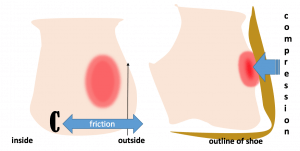
Figure 1 shows two views of the heel (left back, right side view). The area of skin stress is shown in red.
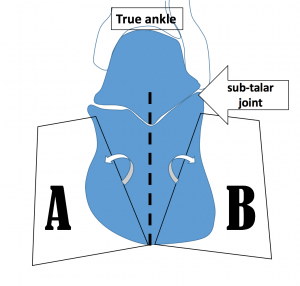
Figure 2. The subtalar joint is shown and pivots sideways toward A (eversion) or B (inversion) during walking. If the movement across both positions increases excessively, the deeper frictional forces cause shearing across the soft parts, which become inflamed.
What is the Solution?
The first consideration is managing any broken skin (acute injury). Prevention is better, so awareness of the shoe, your foot deformity, and the surrounding terrain becomes a helpful formula. Haglund’s ‘syndrome’ suggests (1) the skin might be irritated or that (2) a deep bursa has become inflamed. This might have developed with some (3) tendon involvement. All three components might be present, but often, only the bump causes soreness. If it is simply the communal garden swelling, conservative management can be achieved by altering the heel height in shoe wear or using local protection.
Any self-help management aims to prevent blistering from arising or the skin from breaking and forming a ‘wound’. For anyone with neuropathy, DO NOTE that damage can occur without immediate knowledge. Naturally, this is a more significant concern for patients with diabetes who suffer from numbness or neuropathy.
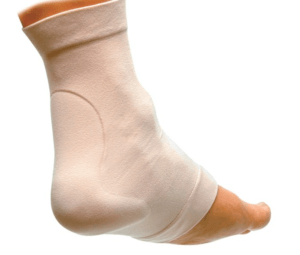
Gel sleeve is made from a thin elastic stocking with a thin spongy pad formed into the sock, as shown.
Acute Problems
A blister patch can alleviate direct skin pressure, but it should be used only when acutely inflamed or where the skin has broken. Blister patches are sold in local pharmacies and chemist outlets.
A wound dressing will help absorb any leaking fluid to prevent infection. Change this regularly until any fluid leakage has stopped. Leave open to air at night so the foot does not stick to the sheets. Place a soft pillow or reposition yourself at night at the back of the leg (above the heel) to take pressure away from the raw skin.
Use a fresh, dry dressing during the day. Avoid any further pressure and reduce the use of dressings unless necessary. Footwear such as flip flops, sandals or Crocs will help limit skin pressure while the skin mends. Pain medication is not required unless the level of pain is high, in which case if this is sustained for more than 2 days, seek help from a professional—regular pain medicines for headaches work. Try not to burst the roof of any blister unless it has become so large it will burst with footwear pressure. To burst a blister, you must use a clean technique. Using a standard antiseptic dressing is better than the recommendation to use Vaseline, and it is certainly preferred over antibiotic creams. As a rule, ointments should not be used on open wounds. There are always exceptions.
Prevention
The use of a siliconised gel sleeve, as shown in the picture above, is highly effective, and I have used this for walks when shoes that I know cause me problems despite fitting well enough. A felt pad cut out stuck to the inside of the shoe is helpful. This is often called a doughnut pad and is similar to the bunion pad I have demonstrated as part of my self-help videos.
Surgery
Most of the formal professional sites I have recommended all say something about surgery. This is not always a successful operation for large bumps. More minor bumps, like mine, would work well enough if operated on. Recovery time is longer than you may realise; no less than 6 weeks and sometimes longer. Surgery is not for the faint-hearted, and the inconvenience has more to do with inconvenience than any lack of success. The usual risks exist, but this is where most sites do offer detailed information. As Vaishya suggests, ‘surgical excision of the bony exostoses of the calcaneum is only required in resistant cases.’ His further advice is also valid. ‘Inflammation of the different parts of soft tissue in the area can lead to an isolated condition; however, the treatment options are different in these conditions, so they should be differentiated.’ This condition can affect one or both heels. A history of arthritic conditions such as gout, rheumatoid arthritis, or seronegative spondyloarthropathies should be considered (Vaishya).
ConsultingFootPain says the best source at the time of publication was ACFS and FootEducation.
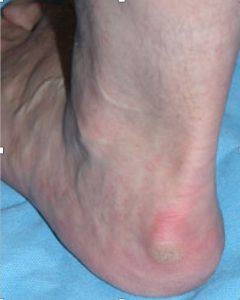
Fig.3 Courtesy College of Podiatry (open access) shows callus formation. The bump is toward the outside of the foot, as in Fig. 1
The American College of Foot Surgeons (good ***) has produced a useful overall impression, as does my usual site, FootEducation (good***), which also uses the term ‘pump bump’. The British Foot and Ankle Society (poor*) does not discuss this condition within its brief discussion of heel pain. At the same time, the Royal College of Podiatry makes a brief statement (see box), but the RCP link seems to have disappeared at last checking!
Some people develop bumps on the back of the heel, often referred to as “pump bumps”. These are often a combination of local skin thickening, bursa and enlargement of the heel bone. This condition requires very careful investigation to determine the extent of the bump and whether there is any bone formed within the tendon. Depending on where the bump is and what structures are involved, treatment can sometimes be very difficult. Surgery is often associated with prolonged recovery and persistent swelling.
Royal College of Podiatry
Reference
Vaishya,R, Agarwal,AK, Azizi,AT, Vijay,V. Haglund’s Syndrome: A Commonly Seen Mysterious Condition. Oct; 8(10): e820. Published online 2016 Oct 7. doi: 10.7759/cureus.820
Thank you for reading The Heel Bump by David R. Tollafield.
David was a former consultant podiatrist (foot) surgeon who operated on many patients. His books include patient journeys. Check out his latest book.

Published by Busypencilcase Communications & Publications. Est. 2015
Modified and edited January 2025
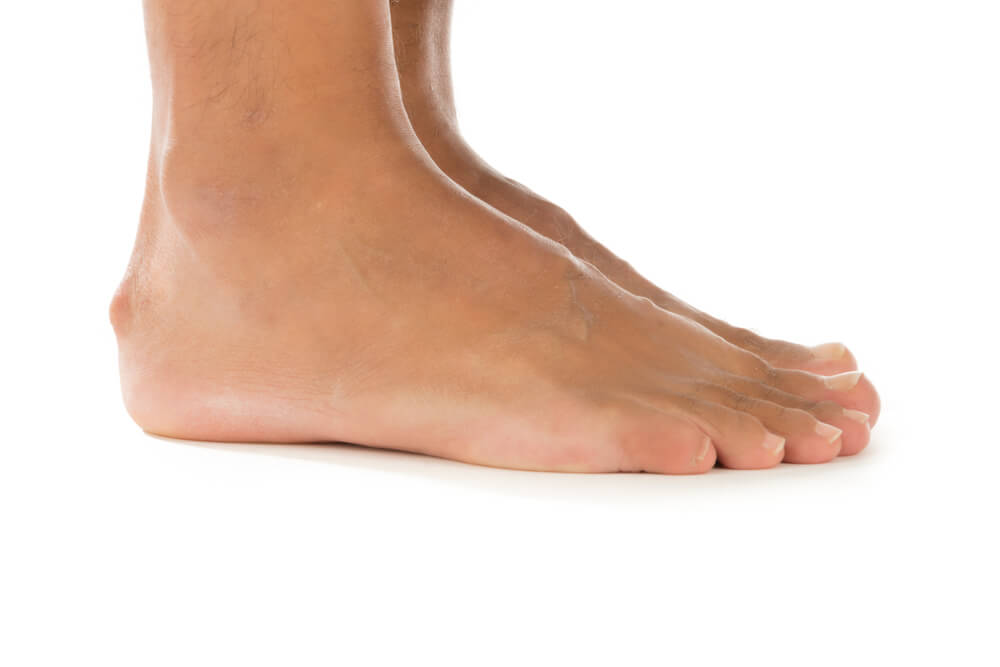
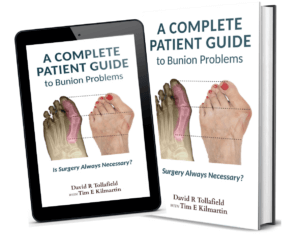
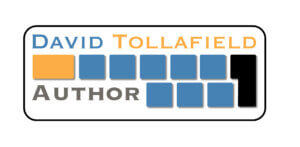
Recent Comments